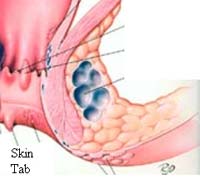How are skin rashes formed?
Perianal skin rashes are amorphous lumps of skin or squamous epithelium located on the lip of the anus. It is a particularly common condition, often associated with other anorectal problems.
Perianal skin rashes are usually the result of a previous affection or injury. An acute swelling of an external hemorrhoid, if not treated, often leaves behind skin rashes, also called hemorrhoidal rashes. Also, swollen skin edges, as a result of previous rectal surgery, can turn into skin rashes.
The “sentinel” spine is located at the lower edge of an infectious lesion or injury, as if it were watching or guarding. Rectal stretch marks and fistula are often associated with secondary changes, which may include a “sentinel” spine. The proximal end of a stretch mark or fistula may have reddish tissue protruding from which the “sentinel” sac is formed.
The cutaneous sac is first identified by the patient, as a soft to the touch, painless protrusion that starts near the opening of the anus. If a skin ridge causes pain, it is often due to the presence of an associated rectal condition, which is the actual cause of the pain.
Maintaining hygiene can be a problem, as fecal debris can become trapped under the sac by cleaning in one direction. If there is more than one wreck, the problem multiplies. Itching often develops to aggravate the problem. Skin rashes may be indicative of the existence of a much more serious rectal condition that needs careful investigation.
How are skin rashes treated?
Skin rashes, which are generally asymptomatic, are often remnants of previous inflammation caused by an injury to the anal area. When the rashes show symptoms as a result of itching, pain, stress, hygiene problems, they can be removed and/or biopsied to confirm the cause.
An orthoscopy can help the doctor determine the cause or find other lesions. If the stitches are small, local anesthesia is used and they are removed. Laser has been successfully used to eliminate skin ridges and repair the anal area, achieving a good result aesthetically. However, if the stretch marks are extensive, then surgery may be required.

